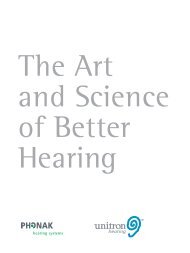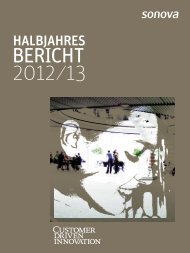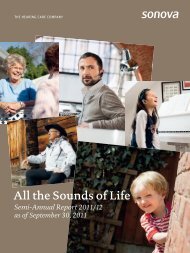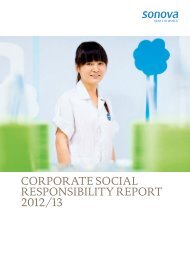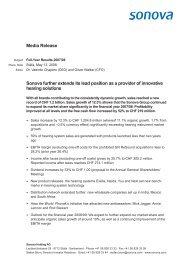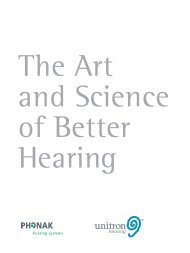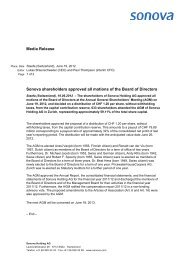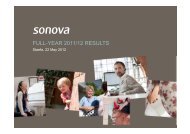ANNUAL REPORT 2008/09 - Sonova
ANNUAL REPORT 2008/09 - Sonova
ANNUAL REPORT 2008/09 - Sonova
You also want an ePaper? Increase the reach of your titles
YUMPU automatically turns print PDFs into web optimized ePapers that Google loves.
Segment reporting<br />
A business segment is a group of assets and op -<br />
era tions engaged in providing products or services<br />
that are subject to risks and returns that are different<br />
from those of other business segments. The<br />
Group is active in one business segment; the design,<br />
development, manufacture, distribution and<br />
service of hearing systems and related products.<br />
A geographical segment is engaged in providing<br />
products or services within a particular economic<br />
environment that are subject to risks and returns<br />
that are diff erent from those of segments operating<br />
in other economic environments. The <strong>Sonova</strong> Group<br />
has set the following geographical segments:<br />
Europe, Americas, Asia/Pacifi c and Rest of world.<br />
Impairment of non-fi nancial assets<br />
The Group assesses at each reporting date whether<br />
there is any indication that an asset may be impaired.<br />
If any such indication exists, the recoverable<br />
amount of the asset is estimated. The recoverable<br />
amount of an asset or, where it is not possible to estimate<br />
the recoverable amount of an individual<br />
asset, a cash-generating unit is the higher of its fair<br />
value less selling costs and its value in use. Value<br />
in use is the present value of the future cash fl ows<br />
expected to be derived from an asset or cash-<br />
generating unit. If the recoverable amount is lower<br />
than the carrying amount, an impairment loss is<br />
recognized. Impairment of fi nancial assets is described<br />
in Note 3.4 Financial assets. For the<br />
purpose of impairment testing, goodwill as well as<br />
corporate assets are allocated to cash generating<br />
units. An annual impairment test is performed in<br />
the fi rst half of each fi nancial year, even if there<br />
is no indication of impairment (see section “business<br />
combinations and goodwill”).<br />
Related parties<br />
A party is related to an entity if the party directly or<br />
indirectly controls, is controlled by, or is under<br />
common control with the entity, has an interest in<br />
the entity that gives it signifi cant infl uence over<br />
the entity, has joint control over the entity or is an<br />
associate or a joint venture of the entity. In ad -<br />
dition, members of the Board of Directors and the<br />
Management Board or close members of their<br />
families are also considered related parties as are<br />
post-employment benefi t plans for the benefi t of<br />
employees of the entity. No related party exercises<br />
control over the Group.<br />
Employee benefi ts (IAS 19)<br />
Pension obligations<br />
Most employees are covered by post-employment<br />
plans sponsored by corresponding Group Companies<br />
in the <strong>Sonova</strong> Group. Such plans are mainly defi<br />
ned contribution plans (future benefi ts are determined<br />
by reference to the amount of contributions<br />
paid) and are generally administered by autonomous<br />
pension funds or independent insurance companies.<br />
These pension plans are fi nanced through employer<br />
and employee contributions. The Group’s contributions<br />
to defi ned contribution plans are charged to<br />
the income statement in the year to which they<br />
relate.<br />
<strong>Sonova</strong> Group also has a number of defi ned benefi t<br />
pension plans, both funded and unfunded. Ac -<br />
counting and reporting of these plans are based on<br />
annual actuarial valuations. Defi ned benefi t ob ligations<br />
and service costs are assessed using the projected<br />
unit credit method: the cost of providing<br />
pensions is charged to the income statement so as<br />
to spread the regular cost over the service lives<br />
of employees participating in these plans. The pension<br />
obligation is measured as the present value<br />
of the estimated future outfl ows using interest rates<br />
of government securities which have terms to ma -<br />
turity approxi mating the terms of the related liability.<br />
CONSOLIDATED FINANCIAL STATEMENTS<br />
71



